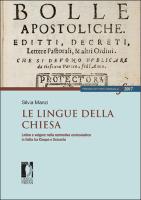Le lingue della Chiesa
Latino e volgare nella normativa ecclesiastica in Italia tra Cinque e Seicento
| dc.contributor.author | MANZI, SILVIA | |
| dc.date.accessioned | 2022-05-31T10:29:53Z | |
| dc.date.available | 2022-05-31T10:29:53Z | |
| dc.date.issued | 2018 | |
| dc.identifier | ONIX_20220531_9788864538860_718 | |
| dc.identifier.issn | 2612-8071 | |
| dc.identifier.uri | https://library.oapen.org/handle/20.500.12657/55434 | |
| dc.language | Italian | |
| dc.relation.ispartofseries | Premio Istituto Sangalli per la storia religiosa | |
| dc.title | Le lingue della Chiesa | |
| dc.title.alternative | Latino e volgare nella normativa ecclesiastica in Italia tra Cinque e Seicento | |
| dc.type | book | |
| oapen.abstract.otherlanguage | In the central centuries of the Modern Age, Latin was the official language of the Church of Rome, but from the analysis of papal edicts and decrees, it emerges that Vernacular was preferred as common language. While opposing the Lutheran doctrine, which favoured to the use of vernacular both in the Scriptures and in the liturgy, and keeping the knowledge of the mysteries of the faith only for those able to understand Latin, Italian bishops and inquisitors used vernacular to transmit papal edicts and conciliar decrees. What topics required complete understanding? Was there loyalty to the originals, or were the margins of interpretation exploited to contain the repressive hold imposed by the post-Tridentine papacy? | |
| oapen.identifier.doi | 10.36253/978-88-6453-886-0 | |
| oapen.relation.isPublishedBy | bf65d21a-78e5-4ba2-983a-dbfa90962870 | |
| oapen.relation.isbn | 9788864538860 | |
| oapen.relation.isbn | 9788864538853 | |
| oapen.relation.isbn | 9788892730304 | |
| oapen.series.number | 6 | |
| oapen.pages | 158 | |
| oapen.place.publication | Florence |

